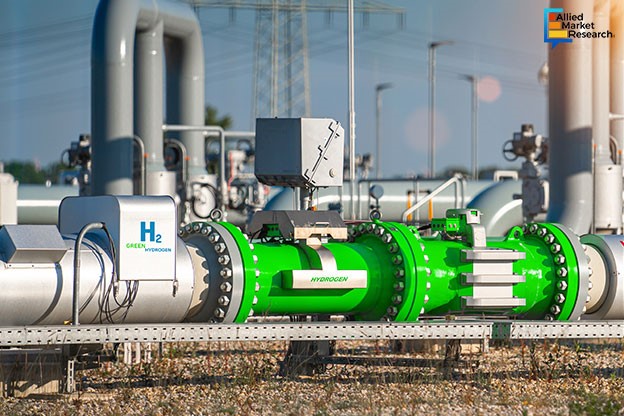How Investment in Green Hydrogen Technology Is a Profitable Business Decision?

26 Apr
2024
Highlights
- Introduction
- The potential of green hydrogen
- Role of advanced monitoring technology
- New service launch and collaboration
Businesses, governments, and investors are impressed by the potential of green hydrogen to address the intermittent solar and wind energy while possessing combustion properties similar to natural gas. Its suitability as a feedstock in industrial chemical processes further enhances its appeal and has garnered significant attention in various sectors. Green hydrogen is formulated via electrolysis that divides water into hydrogen and oxygen molecules, utilizing electricity produced from renewable sources. During electrolysis, hydrogen is extracted from water, resulting in a sustainable fuel that does not emit pollutants or greenhouse gases.
Solid oxide electrolyzer is widely used in green hydrogen production due to its high efficiency and operational advantages. Moreover, solid oxide electrolyzers efficiently use the heat available at elevated temperatures by decreasing the electrical energy quantity required to generate hydrogen from water. The high efficiency and cost-effectiveness of solid oxide electrolyzers make them a favored option for green hydrogen production. Owing to these factors, the solid oxide electrolyzer segment is anticipated to cite a notable CAGR of 51.10% by 2032.
The dynamic potential of green hydrogen
Green hydrogen has significant potential as a fuel across various sectors, especially for generating electricity via hydrogen fuel cells. This application minimizes greenhouse gas emissions, particularly within the energy sector. In addition, industries, such as steel manufacturing, chemical production, and ammonia synthesis frequently necessitate high-temperature heat or high-purity hydrogen. Green hydrogen offers a sustainable alternative to fossil fuels in these processes, effectively reducing emissions.
Moreover, hydrogen fuel cells are power sources for various transportation modes, including cars, trucks, buses, and trains. Vehicles equipped with hydrogen fuel cells emit only water vapor, offering a clean alternative to traditional combustion engines. In addition, hydrogen fuel cell vehicles possess longer driving ranges compared to battery electric vehicles, making them an attractive option for automotive applications.
Real-time monitoring reduces production cost
Key performance indicators (KPIs) for hydrogen production, such as energy consumption, plant performance, production rates, purity, and storage, necessitate visibility to ensure efficient production. AIoT (Artificial Intelligence of Things) facilitates rapid error detection through intelligent alarms, sensors on assets monitoring KPIs, and cloud-based remote monitoring beyond control rooms. Real-time monitoring and remote control reduce costs through energy optimization and workforce efficiency.
Evolving landscape of Saudi Arabia's green hydrogen industry
Saudi Arabia's emphasis on renewable energy projects and decarbonization initiatives has propelled the growth of the green hydrogen sector within the country. Saudi Arabia has invested in renewable energy projects, with a focus on solar and wind power. These projects are expected to provide the necessary renewable energy input for green hydrogen production, further supporting the growth of the green hydrogen industry in the country. Owing to this, the Saudi Arabia Green Hydrogen industry is estimated to cite the fastest CAGR of 50.30% from 2023 to 2032.
Top entities adopted novel strategies to lead their supremacy in the evolving industry
The global green hydrogen sector is highly competitive and top entities are engaged in strategic alliances to strengthen their position in the industry. These strategies include collaborations, mergers, partnerships, acquisitions, and new product launches. For instance, in April 2024, a leading industrial gas company, Linde, disclosed that White Martins, its subsidiary, is projected to construct, own, and manage a 5MW pressurized alkaline electrolyzer in Jacareí, São Paulo state, Brazil. This initiative is aimed at providing hydrogen to support the local glass industry. The upcoming facility in Jacareí is expected to mark Linde's second hydrogen production site in Brazil. Linde has been producing certified green hydrogen in the state of Pernambuco since 2022.
Again, in April 2024, a prominent provider of hydrocarbon-based products, Haltermann Carless, and the UK’s foremost electricity producer, RWE, signed a Memorandum of Understanding (MoU) to collaborate on the development of a green hydrogen facility in Harwich, Essex. The project involves installing an electrolyzer at the Haltermann Carless industrial site, recognized for its fuel additives and agrochemicals production.
To conclude, green hydrogen’s suitability as a feedstock in industrial chemical processes has enhanced its appeal and garnered significant attention in various sectors. Green hydrogen offers a sustainable alternative to fossil fuels in industrial processes, effectively reducing emissions. Moreover, top entities have expanded their products and services by adopting novel strategies.
To gain deeper insights into the future projections and competitive scenario of the global green hydrogen sector, connect us!

Koyel Ghosh
Author’s Bio- Koyel Ghosh is a blogger with a strong passion and enjoys writing in miscellaneous domains, as she believes it lets her explore a wide variety of niches. She has an innate interest in creativity and enjoys experimenting with different writing styles. A writer who never stops imagining, she has been serving the corporate industry for the last five years.
Which Upcoming Trends in the Forklift Battery Industry Should Battery Manufacturing Businesses Be Aware of?
Avenue: Entire Library membership of Allied Market Research Reports at your disposal
- Avenue is an innovative subscription-based online report database.
- Avail an online access to the entire library of syndicated reports on more than 2,000 niche industries and company profiles on more than 12,000 firms across 11 domains.
- A cost-effective model tailored for entrepreneurs, investors, and students & researchers at universities.
- Request customizations, suggest new reports, and avail analyst support as per your requirements.
- Get an access to the library of reports at any time from any device and anywhere.
Related Post
-
How are Submarine Cables Transforming Global Connectivity with Enhanced User Experience?
-
Endoscopy Procedures: Transformations in Techniques and Applications
-
AI-Powered Video Analytics: How the Product Actually Works for enterprises
-
Painting Robots: Transforming Precision Coating and Creative Applications
-
Innovations in Pharmacovigilance Systems Advancing Patient Safety
-
Understanding Edge Security: Keeping Data Safe Near the Source
-
Exploring the Use and Advancements of 3D Laser Scanners in Professional Applications
-
Reinforcing Industrial Controls with Smarter Tools and Training








